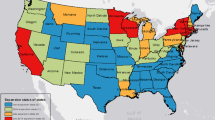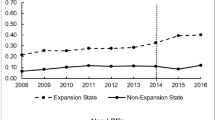Abstract
Immigrants’ access to public benefits, including healthcare coverage, has remained at the front and center of the debate on immigration and welfare policy in many host countries. As policymakers in the USA engage in ongoing discussions about expanding Medicaid, including extending access to immigrants, some concerns have been raised regarding the potential for insurance expansion to attract more immigrants who may relocate in search of free health insurance coverage. Using the Affordable Care Act (ACA) Medicaid expansions as a natural experiment setup, I examined the impact of the ACA Medicaid expansion on the interstate migration of low-income immigrants. Unlike previous papers that examined the effect of public insurance expansion on interstate movement of the low-income population in general, I specifically focus on the immigrant population. Using individual-level data from the American Community Surveys over 2009–2018, results from difference-in-difference analyses indicate that the expansion of the ACA in some states has no statistically significant effect on in-migration and a decrease in out-migration among the low-income immigrant population. This finding suggests that expanding Medicaid through ACA does not incur the large-scale added cost associated with increased in-migration of low-income immigrants. The results are robust to various sensitivity tests, including alternate policy variables of overall states’ Medicaid generosity index.



Similar content being viewed by others
Notes
Under PRWORA’s qualified aliens include lawful permanent residents, asylees, refugees, and some other groups. This baseline rule, which has some exceptions, bars nonqualified aliens such as holders of Temporary Protected Status (TPS), recipients of Deferred Action for Childhood Arrivals (DACA), and nonimmigrants from receiving federal public benefits.
There are few exceptions to this 5 year wait period. For example, refugees, asylees, or legal permanent residents who used to be refugees or asylees do not have to wait 5 years. However, states have the option to remove the 5-year waiting period and cover lawfully residing children and/or pregnant women in Medicaid or CHIP. For children and pregnant people, states can eliminate the 5-year wait and extend coverage to lawfully present immigrants without a qualified status. Currently, twenty-nine states, plus the District of Columbia, have chosen to provide Medicaid coverage to lawfully residing children and/or pregnant women without a 5-year waiting period.
I used a method developed by Borjas and Cassidy (2019) to differentiate between documented and potentially undocumented immigrants. Borjas and Cassidy (2019) identified foreign-born person as documented/legal if any of the following conditions hold: arrived before 1980; the person is a citizen; person receives Social Security benefits, SSI, Medicaid, Medicare, or Military Insurance; the person is a veteran, or is currently in the Armed Forces; that person works in the government sector; person resides in public housing or receives rental subsidies, or that person is a spouse of someone who resides in public housing or receives rental subsidies; that person was born in Cuba; that person's occupation requires some form of licensing; that person's spouse is a legal immigrant or citizen. For purpose of this paper, the condition of public insurance coverage (Medicaid) is relaxed in constructing potential undocumented immigrant population.
Local immigration enforcement policies under section 287(g) and the Secure Communities are taken from the Immigration and Customs Enforcement (ICE) website archives (ICE, 2009; ICE, 2013; ICE, 2018). Information on state policies specific to undocumented immigrants, namely, state dream act, eligibility for driver’s license, and E-Verify requirements are from Kaushal et al. (2018), and the National Conference of State Legislatures (NCSL) websites.
The results for the sample restricted to immigrants who are more likely to be documented are presented in the Appendix Table 10.
References
Alm, J., & Enami, A. (2017). Do government subsidies to low-income individuals affect interstate migration? Evidence from the Massachusetts Health Care Reform. In Working Papers (No. 1703; Working Papers). Tulane University, Department of Economics https://ideas.repec.org/p/tul/wpaper/1703.html
American Immigration Council. (2021). Immigrants in the United States. https://www.americanimmigrationcouncil.org/research/immigrants-in-the-united-states. Accessed 25 Nov 2022.
Bartel, A. P. (1989). Where Do the New US Immigrants Live? Journal of Labor Economics, 7(4), 371–391. https://doi.org/10.1086/298213
Basso, G., & Peri, G. (2020). Internal mobility: The greater responsiveness of foreign-born to economic conditions. Journal of Economic Perspectives, 34(3), 77–98. https://doi.org/10.1257/jep.34.3.77
Bauer, T., Epstein, G., & Gang, I. (2002). Herd effects or migration networks? The location choice of Mexican immigrants in the US (IZA Discussion Paper No. 551). Institute of Labor Economics (IZA) https://econpapers.repec.org/paper/izaizadps/dp551.htm
Bohn, S., Lofstrom, M., & Raphael, S. (2014). Did the 2007 legal Arizona Workers Act reduce the state’s unauthorized immigrant population? The Review of Economics and Statistics, 96(2), 258–269.
Borhade, A., & Dey, S. (2018). Do migrants have a mortality advantage? The Lancet, 392(10164), 2517–2518. https://doi.org/10.1016/S0140-6736(18)33052-6
Borjas, G., & Cassidy, H. (2019). The wage penalty to undocumented immigration. Labour Economics, 61, 101757 https://econpapers.repec.org/article/eeelabeco/v_3a61_3ay_3a2019_3ai_3ac_3as0927537119300831.htm
Borjas, G., & Hilton, L. (1996). Immigration and the welfare state: Immigrant participation in means-tested entitlement programs. The Quarterly Journal of Economics, 111(2), 575–604.
Borjas, G. J. (1989). Economic theory and international migration. International Migration Review, 23(3), 457–485. https://doi.org/10.1177/019791838902300304
Borjas, G. J. (1999). Immigration and welfare magnets. Journal of Labor Economics, 17(4), 607–637. https://doi.org/10.1086/209933
Borjas, G. J. (2001). Does immigration grease the wheels of the labor market? Brookings Papers on Economic Activity, 32(1), 69–134.
Brooks T, Gardner A, Tolbert J, Dolan R, Pham O. (2021). Medicaid and CHIP eligibility and enrollment policies as of January 2021: Findings from a 50-state survey. https://www.kff.org/medicaid/report/medicaid-and-chip-eligibility-and-enrollment-policies-as-of-january-2021-findings-from-a-50-state-survey/
Buchmueller, T. C., Lo Sasso, A. T., Lurie, I., & Dolfin, S. (2007). Immigrants and employer-sponsored health insurance. Health Services Research, 42(1 Pt 1), 286–310. https://doi.org/10.1111/j.1475-6773.2006.00600.x
Bustamante, A. V., Chen, J., McKenna, R. M., & Ortega, A. N. (2019). Health care access and utilization among US immigrants before and after the Affordable Care Act. Journal of Immigrant and Minority Health, 21(2), 211–218. https://doi.org/10.1007/s10903-018-0741-6
Callaway, B., & Sant’Anna, P. H. C. (2020). Difference-in-differences with multiple time periods. Journal of Econometrics, 225, 200–230. https://doi.org/10.1016/j.jeconom.2020.12.001
Card, D. (2005). Is the new immigration really so bad? The Economic Journal, 115(507), F300–F323.
Carrasquillo, O., Carrasquillo, A. I., & Shea, S. (2000). Health insurance coverage of immigrants living in the United States: Differences by citizenship status and country of origin. American Journal of Public Health, 90(6), 917–923.
Cebula, R. J., & Clark, J. R. (2013). An extension of the Tiebout hypothesis of voting with one's feet: The Medicaid magnet hypothesis. Applied Economics, 45(32), 4575–4583.
Center, P. R. (2015). Chapter 2: Immigration’s impact on past and future US population change. In Pew Research Center's Hispanic Trends Project https://www.pewresearch.org/hispanic/2015/09/28/chapter-2-immigrations-impact-on-past-and-future-u-s-population-change/
Congressional Research Service. (2013). Noncitizen eligibility for public benefits: legal issues 33.
de Graauw, E., & Bloemraad, I. (2017). Working together: Building successful policy and program partnerships for immigrant integration. Journal on Migration and Human Security, 5(1), 105–123. https://doi.org/10.1177/233150241700500106
Derose, K. P., Escarce, J. J., & Lurie, N. (2007). Immigrants and health care: Sources of vulnerability. Health Affairs, 26(5), 1258–1268. https://doi.org/10.1377/hlthaff.26.5.1258
Dunlevy, J. A. (1991). On the settlement patterns of recent Caribbean and Latin immigrants to the United States. Growth and Change, 22(1), 54–67. https://doi.org/10.1111/j.1468-2257.1991.tb00541.x
Fox, A. M., Feng, W., Zeitlin, J., & Howell, E. A. (2020). Trends in state Medicaid eligibility, enrollment rules, and benefits health affairs, 39(11), 1909–1916.
Friedberg, R. M., & Hunt, J. (1995). The impact of immigrants on host country wages, employment and growth. The Journal of Economic Perspectives, 9(2), 23–44.
Goodman, L. (2017). The effect of the Affordable Care Act Medicaid expansion on migration. Journal of Policy Analysis and Management, 36(1), 211–238. https://doi.org/10.1002/pam.21952
Goodman-Bacon, A. (2021). Difference-in-differences with variation in treatment timing. Journal of Econometrics, 225(2), 254–277. https://doi.org/10.1016/j.jeconom.2021.03.014
Gramlich, E. M., & Laren, D. S. (1984). Migration and income redistribution responsibilities. The Journal of Human Resources, 19(4), 489–511. https://doi.org/10.2307/145944
Hayden, N., & Bharath, D. (2019). Even in Deep Blue California, Medi-Cal expansion for undocumented doesn’t sit well with some. Center for Health Journalism https://centerforhealthjournalism.org/even-deep-blue-california-medi-cal-expansion-undocumented-doesn-t-sit-well-some
Jaeger, D. A. (2006). Green Cards and the location choices of immigrants in the United States, 1971-2000. IZA Discussion Papers, No. 2145, 58.
Kaestner, R., Kaushal, N., & Van Ryzin, G. (2003). Migration consequences of welfare reform. Journal of Urban Economics, 53(3), 357–376. https://doi.org/10.1016/S0094-1190(03)00005-6
Kaushal, N. (2005). New immigrants’ location choices: Magnets without welfare. Journal of Labor Economics, 23(1), 59–80. https://doi.org/10.1086/425433
Kaushal, N., & Muchomba, F. M. (2023). Cost of public health insurance for US-born and immigrant adults. JAMA Netw Open., 6(9), e2334008. https://doi.org/10.1001/jamanetworkopen.2023.34008
Kaushal, N., Wang, J. S.-H., & Huang, X. (2018). State dream acts and education, health and mental health of Mexican young adults in the US. Economics & Human Biology, 31, 138–149. https://doi.org/10.1016/j.ehb.2018.08.013
KFF. (2013). Summary of the Affordable Care Act. KFF https://www.kff.org/health-reform/fact-sheet/summary-of-the-affordable-care-act/. Accessed 16 Oct 2022.
KFF. (2021). Health coverage of immigrants. KFF https://www.kff.org/racial-equity-and-health-policy/fact-sheet/health-coverage-of-immigrants/. Accessed 16 Oct 2022.
NSCL. (2017). Immigrant eligibility for health care programs in the United States. https://www.ncsl.org/research/immigration/immigrant-eligibility-for-health-care-programs-in-the-united-states.aspx. Accessed 12 Nov 2022.
Razin, A., & Wahba, J. (2015). Welfare magnet hypothesis, fiscal burden, and immigration skill selectivity. The Scandinavian Journal of Economics, 117(2), 369–402. https://doi.org/10.1111/sjoe.12092
Riosmena, F., Kuhn, R., & Jochem, W. C. (2017). Explaining the immigrant health advantage: Self-selection and protection in health-related factors among five major national-origin immigrant groups in the United States. Demography, 54(1), 175–200. https://doi.org/10.1007/s13524-016-0542-2
Rudowitz, R., Garfield, R., & Hinton, E. (2019). 10 things to know about Medicaid: Setting the facts straight. KFF https://www.kff.org/medicaid/issue-brief/10-things-to-know-about-medicaid-setting-the-facts-straight/
Ruggles, S., Flood, S., Foster, S., Goeken, R., Pacas, J., Schouweiler, M., & Sobek, M. (2021). PUMS USA: Version 11.0 [dataset] Minneapolis, MN: IPUMS, 2021. 10.18128/D010.V11.0
Schündeln, M. (2014). Are immigrants more mobile than natives? Evidence from Germany. Journal of Regional Science, 54(1), 70–95. https://doi.org/10.1111/jors.12072
Schwartz, A. L., & Sommers, B. D. (2014). Moving for Medicaid? Recent eligibility expansions did not induce migration from other states. Health Affairs, 33(1), 88–94. https://doi.org/10.1377/hlthaff.2013.0910
Simon, K., Soni, A., & Cawley, J. (2017). The impact of health insurance on preventive care and health behaviors: Evidence from the first two years of the ACA Medicaid expansions. Journal of Policy Analysis and Management, 36(2), 390–417. https://doi.org/10.1002/pam.21972
Smith, J. P., & Edmonston, B. (1997). The New Americans: economic, demographic, and fiscal effects of immigration (National Research Council.). The National Academies Press. https://doi.org/10.17226/5779
Soni, A. (2020). The effects of public health insurance on health behaviors: Evidence from the fifth year of Medicaid expansion. Health Economics, 29(12), 1586–1605. https://doi.org/10.1002/hec.4155
Southwick, L., Jr. (1981). Public welfare programs and recipient migration. Growth and Change, 12(4), 22–32. https://doi.org/10.1111/j.1468-2257.1981.tb00688.x
Tarraf, W., Jensen, G. A., Li, Y., Toseef, M. U., Mahmoudi, E., & Gonzalez, H. M. (2021). Changes in insurance coverage and healthcare use among immigrants and US-born adults following the Affordable Care Act. Journal of Racial and Ethnic Health Disparities, 8(2), 363–374. https://doi.org/10.1007/s40615-020-00790-y
Watson, T. (2013). Enforcement and immigrant location choice (SSRN Scholarly Paper ID 2512416). Social Science Research Network. https://doi.org/10.2139/ssrn.2512416
Yasenov, V. I., Lawrence, D., Mendoza, F. S., & Hainmueller, J. (2020). Public health insurance expansion for immigrant children and interstate migration of low-income immigrants. JAMA Pediatrics, 174(1), 22–28. https://doi.org/10.1001/jamapediatrics.2019.4241
Author information
Authors and Affiliations
Corresponding author
Ethics declarations
Competing Interests
The author declares no competing interests.
Additional information
Publisher’s Note
Springer Nature remains neutral with regard to jurisdictional claims in published maps and institutional affiliations.
Appendix
Appendix
Rights and permissions
Springer Nature or its licensor (e.g. a society or other partner) holds exclusive rights to this article under a publishing agreement with the author(s) or other rightsholder(s); author self-archiving of the accepted manuscript version of this article is solely governed by the terms of such publishing agreement and applicable law.
About this article
Cite this article
Rigzin, T. Medicaid Expansion Through the Affordable Care Act and Interstate Mobility of Low-Income Immigrants: Welfare Magnet or Myth?. Int. Migration & Integration (2023). https://doi.org/10.1007/s12134-023-01105-w
Accepted:
Published:
DOI: https://doi.org/10.1007/s12134-023-01105-w




